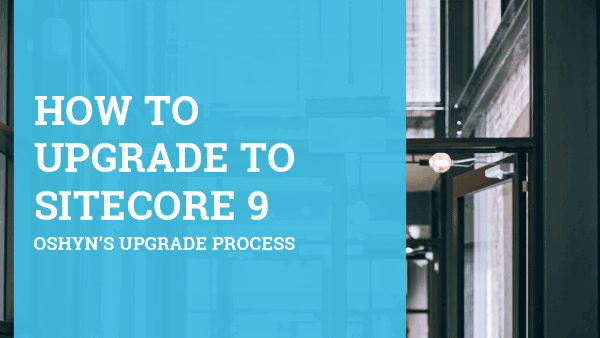
Planning a Sitecore Upgrade? Here’s How to Choose the Right Upgrade Partner




May 02, 2022
Is it time for you to upgrade your Sitecore implementation? Here’s what to look for in your Sitecore upgrade partner.
Upgrading is a natural part of the software lifecycle. Upgrading your Sitecore implementation is the best way to keep it in good working condition. It’s also (as the C-team loves to hear) the best way to arm your marketers with the latest features and ensure you’re getting the most out of your investment.
If you’re sitting on Sitecore 9, 8, 7, or—heaven forbid—6, you’re missing out on a ton of functionality that could be moving the needle for your business. And while your marketers are missing out, your developers are suffering the headaches of maintaining an older solution.
Implementing Sitecore is complex. Upgrading Sitecore can be far more complex—especially if you have technical debt, and you’ve put off upgrading for a number of years.
You already know the benefits of upgrading to Sitecore 10. The next step is finding the right partner to help you do it in the most cost-efficient way, minimizing the blow to your budget and getting your team up and running as quickly as possible.
The traditional approach to upgrading Sitecore
In many cases companies try to approach upgrading Sitecore as an incremental process. You started out with Sitecore 6. Then, you upgraded from 6.1 to 6.2, then 6.2 to 6.3, and so on until you made it to Sitecore 10, testing along the way to ensure no surprises pop up.
Unfortunately, this rarely matches what we see in reality.
Most Sitecore clients find themselves having to bridge huge gaps in versions. They see other Sitecore websites operating at peak performance, complete with rich personalization and testing features. Meanwhile, their old Sitecore environment is throttling their business goals. It lags, it’s hard to maintain, and it’s missing the latest and greatest features. Eventually, they reach a point where they’re fed up, so they decide to make the upgrade. Soon after, they find a Sitecore partner, who happily sells them one.
Sounds ideal, right? Not quite.
Here’s the catch: with each subsequent upgrade you perform, you incur risk. There’s always something that could break. That’s the value of making small, incremental upgrades: you can catch those breakages fairly quickly.
When you perform an upgrade across multiple versions, your risk multiplies exponentially. Not only is there more risk, there are usually a lot more breaks—which are larger in scope and harder to catch. While your developers scramble to root out the cause, your site could go down and you could be losing revenue.
What an incremental Sitecore upgrade looks like when you have the right partner
It’s easy to say the right Sitecore upgrade partner puts your needs and interests first.
Here’s what that actually looks like:
Step 1: Discovery
Every Sitecore upgrade should start with an audit—
During this stage, the Sitecore partner will have discussions with you and your team to understand the current obstacles you’re facing with your Sitecore environment, and the type of functionality you’d like to achieve. They’ll then review your existing implementation to determine the most cost-efficient path for upgrading to Sitecore 10 and implementing those new features.
This Sitecore audit should cost no more than $10,000.
Step 2: Planning
Each Sitecore upgrade is unique. The planning process for you will depend on the state of your current environment, the version of Sitecore you’re upgrading to, and other factors.
Just to give you an idea of what you can expect, though, here’s an overview of the questions we ask while planning a Sitecore upgrade for one of our clients at Oshyn. In this example, we’re upgrading a client from an older version to Sitecore 10 on Azure.
-
What modules does the solution currently utilize, and are they still supported on the target version of Sitecore? In some cases, particularly with third-party modules, the module may have been abandoned. In those cases that functionality will have to be replaced with something else.
-
Is the client using Web Forms for Marketers? Web Forms is only supported up to version 9.0. All later versions (9.1 and up) use the brand new Sitecore Forms tool. We create a transition plan to migrate the client away from Web Forms for Marketers, and include a demo of the Sitecore Forms tool in our training documentation.
-
What search solution are they using? If the client has an older version of Sitecore, it’s fairly likely that they are still using Lucene for search, which is essentially not an option in Sitecore 9 and above. Their search implementation will have to be reconfigured to work with a supported search provider (like Solr) and may require code changes as well.
-
What about analytics? If the client is using MongoDB for analytics data, we strongly recommend that they move over to Azure SQL or MSSQL instead, as they’re more performant on Sitecore 9 and above. Additionally, if they have existing analytics data that they want to keep, we create a plan for transitioning that to the new upgraded environment.
-
Is there anything else that needs to be accounted for in the new environment? For example, we have to ensure that the source code will build with the target version of Sitecore. There may be breaking API changes, etc. that need to be addressed. With all those questions answered, and everything else accounted for, we finalize our plan for building out the new environment on Sitecore 10. Then, we begin building.
Step 3: Upgrade
Assuming we’re past all of that, we’ll first run through the upgrade process on a local machine. That process looks something like this:
-
Run some SQL scripts to update database schema.
-
Run the Sitecore Update Installation Wizard to update the local environment (webroot, configuration, and Sitecore data items) to the target version.
-
Run some additional SQL scripts post-upgrade to finalize any schema changes.
-
Run a few post-upgrade tasks.
-
Test to make sure the new site works.
Ideally, we’ll be deploying the upgraded site to a new Azure PaaS environment (that has already been spun up). If that’s the case, we’d continue with the following:
-
Move all the content over. This could either mean we use the local databases we upgraded (if so, we would have gotten recent copies) and import them to Azure, or we would migrate the content over via packages.
-
Set up build and deploy to Azure.
-
Perform internal QA with our team of CMQA (Configuration Management Quality Assurance) Technicians.
-
Run the final build through Client Acceptance.
-
Rinse and repeat. That’s right — this process is then repeated for each of the client’s environments. Once Client Acceptance is complete, we grab the latest data from the live site, import it in Azure, and then point things to Azure.
Step 4: Training
At this stage your Sitecore upgrade may be complete, but your Sitecore partner’s still not done delivering everything you need to maximize the value out of your new upgrade.
Any good Sitecore partner will then take the time to provide personalized training on all the new features and functionalities of your upgraded Sitecore environment. In fact, training should be baked into your Statement of Work from the beginning. This is not something that should NOT be overlooked during the sales process.
Make sure your partner takes training seriously. Get examples of their training documentation. Understand how they go about delivering training. For example, do they have a dedicated staff? Do they provide step-by-step instructions using screenshots from your actual implementation?
You’ve put in the work to unlock these new features and performance improvements for your business; now it’s time for your team to reap the benefits by using them!
Step 5: Success
At last, you’ve upgraded to Sitecore 10, and you feel confident about your site moving forward.
Deployments go smoothly. Content gets created, edited, and published with ease. Personalization and A/B tests are all working as expected. Team members have the right permissions, and the right training, to work in Sitecore and optimize your site.
Now that’s what a successful Sitecore upgrade looks like.
You’ve got options though
As we said at the top, upgrading Sitecore can be a daunting task. But the good news is that this doesn’t have to be the case. You’ve got options.
Instead of going through the entire process outlined above, you could shed your technical debt and get on a new codebase that adheres to Sitecore Helix principles, is fully responsive, easy to manage, and compliant with modern accessibility and data privacy laws. This approach is a favorite among many Sitecore clients precisely because it’s quick, it’s cost-efficient, and it eliminates a massive amount of risk.
At Oshyn, we call it a lift & shift. Our process will have you up and running faster than any Sitecore shop in the world. And when you choose this approach, you put your limited time and budget to better use by eliminating the need for an audit.
What’s the best upgrade approach for you? Let’s discuss.
There’s no one-size-fits-all approach to getting you on the latest version of Sitecore. At Oshyn, we help you weigh the costs and benefits of each option, plan for success, and execute like pros.
Call us to discuss your situation. Schedule a time to talk now.





